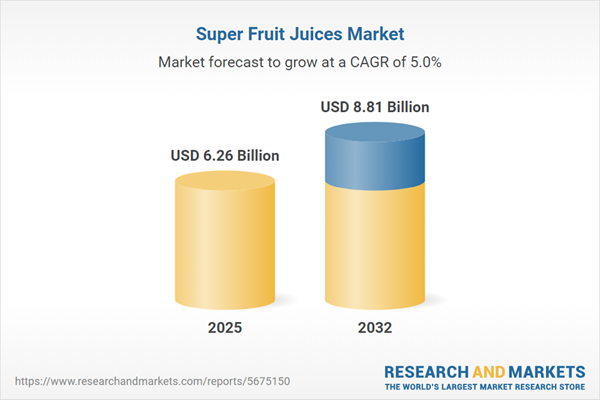Speak directly to the analyst to clarify any post sales queries you may have.
The super fruit juices market is rapidly evolving as businesses respond to rising health priorities, the demand for transparent supply chains, and shifting consumer preferences. Senior decision-makers require timely, data-driven insights to guide competitive strategies and secure long-term growth in this complex and dynamic sector.
Market Snapshot: Global Super Fruit Juices Market Growth and Outlook
The global super fruit juices market is experiencing robust expansion, underpinned by consumers’ pursuit of nutrient-dense beverages and healthy lifestyles. Industry stakeholders are intensifying their efforts around product development, supply chain resilience, and operational excellence. Companies are proactively investing in research and adapting their models to meet evolving health and quality standards. The increasing integration of super fruit juices across beverage portfolios promotes diversification and market adaptability. Established and newcomer brands are pivoting quickly to capitalize on emerging trends and consumer shifts, pointing to sustained opportunity in this sector.
Scope & Segmentation: Key Segments in the Super Fruit Juices Market
- Product Types: Includes pasteurized juices, UHT-processed options, cold-pressed varieties, and not-from-concentrate lines, each tailored to meet specific functional and demographic needs.
- Packaging: Available in cartons, glass, PET bottles, and pouches, supporting demand from both single-serve buyers and institutional clients requiring larger volumes.
- Distribution Channels: Distributed through convenience and grocery stores, hybrid retail platforms, e-commerce, and mobile channels, ensuring multi-channel consumer reach.
- Fruit Varieties: Offers both multi-fruit blends like citrus-berry combinations and single-source juices such as acai, blueberry, goji, mango, and pomegranate, catering to diverse regional tastes and health expectations.
- Source: Incorporates conventional and organic juice options as well as fair trade certified selections, responding to sustainability and ethical sourcing objectives.
- Regions and Key Markets: Encompasses the Americas, Europe, Middle East, Africa, and Asia-Pacific, each reflecting distinct market maturity, consumer behavior, and growth potential.
- Technology Innovations: Employs high-pressure processing, cold pressing, pulsed electric field techniques, digital twins, enhanced production automation, advanced packaging, and predictive analytics to boost product safety and regulatory compliance.
- Leading Competitors: Features global brands like The Coca-Cola Company, PepsiCo, Keurig Dr Pepper Inc., Ocean Spray Cranberries, National Grape Cooperative Association, and focused regional players with specialized market approaches.
Key Takeaways for Senior Decision-Makers
- Supply chain transparency is being strengthened as companies respond to increased consumer awareness and document ingredient sourcing and health benefits in detail.
- Brands advance differentiation through clean-label and cold-pressed juice innovations, bolstering premium product lines and meeting consumer demand for quality.
- Comprehensive digitalization streamlines operations, amplifies sustainability gains, and maintains product consistency by leveraging advanced analytics at each stage.
- Diversified sales frameworks spanning online, brick-and-mortar, and subscription channels cater to a broad spectrum of purchasing habits and expand access to target markets.
- Regional business strategies are aligned to local regulatory landscapes and consumer sophistication, strengthening risk management and capturing emerging opportunities.
Tariff Impact: Navigating Shifts in US Trade Policy
Adjustments in US tariff frameworks are prompting leading super fruit juice companies to rethink sourcing strategies and supply chain footprints. Nearshoring, local partnerships, and enhanced domestic production are key tactics used to control operational costs, sustain supply reliability, and preserve strategic advantage during periods of tariff change.
Methodology & Data Sources
This market analysis is based on a mixed-methods research design, integrating executive interviews, direct consumer input, trusted industry databases, and rigorous compliance documentation. This triangulation delivers reliable, executive-ready insights tailored for strategic planning.
Why This Super Fruit Juices Market Report Matters
- Enables C-level leaders to benchmark strategies in product development, technology deployment, and operational streamlining against established industry standards for superior execution.
- Provides actionable intelligence on digital transformation, regional drivers, and shifting consumer preferences, supporting swift tactical decisions and market entry optimization.
Conclusion
This report equips decision-makers with the insights needed to drive product innovation, fortify operational strategies, and successfully implement digital advancements for sustained competitive growth in the super fruit juices market.
Additional Product Information:
- Purchase of this report includes 1 year online access with quarterly updates.
- This report can be updated on request. Please contact our Customer Experience team using the Ask a Question widget on our website.
Table of Contents
3. Executive Summary
4. Market Overview
7. Cumulative Impact of Artificial Intelligence 2025
List of Figures
Samples

LOADING...
Companies Mentioned
The key companies profiled in this Super Fruit Juices market report include:- The Coca-Cola Company
- PepsiCo, Inc.
- Keurig Dr Pepper Inc.
- Ocean Spray Cranberries, Inc.
- National Grape Cooperative Association, Inc.
- National Beverage Corp.
- Del Monte Foods, Inc.
- The J. M. Smucker Company
- Campbell Soup Company
- Hain Celestial Group, Inc.
Table Information
| Report Attribute | Details |
|---|---|
| No. of Pages | 198 |
| Published | October 2025 |
| Forecast Period | 2025 - 2032 |
| Estimated Market Value ( USD | $ 6.26 Billion |
| Forecasted Market Value ( USD | $ 8.81 Billion |
| Compound Annual Growth Rate | 5.0% |
| Regions Covered | Global |
| No. of Companies Mentioned | 11 |









